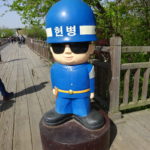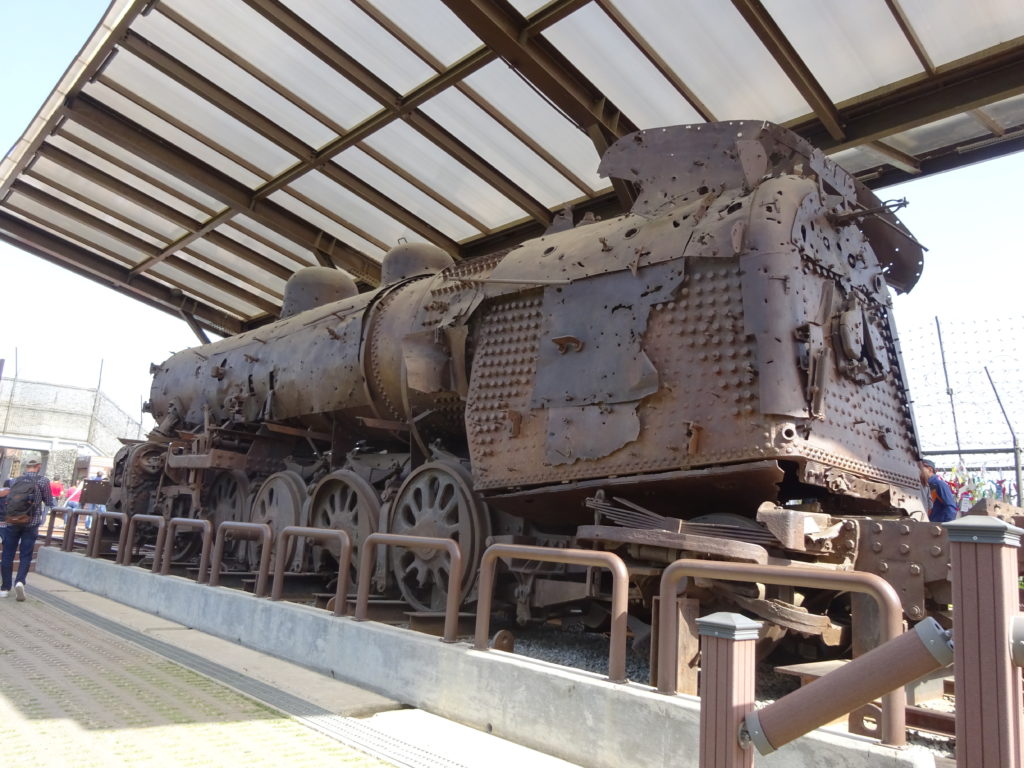 Recently, while North Korea was firing test missiles into the surrounding sea and China/South Korea tensions were heightened due to the THAAD controversy, I took a walk along the fine line that is the DMZ – the Demilitarized Zone between North and South Korea.
Recently, while North Korea was firing test missiles into the surrounding sea and China/South Korea tensions were heightened due to the THAAD controversy, I took a walk along the fine line that is the DMZ – the Demilitarized Zone between North and South Korea.
The area near the DMZ is anything but demilitarized, with armed guards stand at close firing distance from each other. Indeed, shortly after my visit South Korean soldiers fired upon what appeared to be North Korean drone flying over the border. Razor-wire fences line the road and river as you approach the DMZ, ostensibly to keep out invading forces, but in practice more to keep out spies and refugees floating down the river from the northern side of the border. The DMZ itself is a buffer zone, a strip of land extending 2 kilometers north and south of the border. Less than an hour from Seoul, we were able to get inside of the South Korean limits of the DMZ and go right up to the border itself.

Our first stop was at Imjingak Tourist Resort, which was a weird combination of remnants from the war (shot up rusty steam locomotive engine, Freedom Bridge, monuments, etc.) and carnival rides and miniature golf course. It was designed as a sort of consolation to those who couldn’t return to their hometowns, friends, and families because of the split between North and South Korea.
From there we went to the “3rd tunnel of aggression,” one of four tunnels the North Koreans had built as potential attack routes. To reach this point we needed to go through a South Korean military checkpoint where soldiers checked our passports individually before we ran a gauntlet of zigzagged barriers, spiked blockades, and even more razor wire. On the way back out of the DMZ more soldiers checked our passports again to make sure we hadn’t left anyone behind.
 After seeing a video explaining the “3rd tunnel” and walking through a small museum, we donned hard hats for hike into the tunnel system. A long, steep access passage high enough to walk comfortably brought us steeply downward (358 meters long, 3 meters diameter, 11 degree angle) to a point where it intersected with the original tunnel of aggression. This “3rd tunnel” was very narrow (two people could barely squeeze sideways) with low ceilings (our hard hats dinged the ceiling routinely). Totaling 1,625 meters long, the 2 meter high and 2 meter wide tunnel sits 73 meters below the surface. About 1,200 meters of it is on the North Korean side of the demarcation (border) line, with 435 meters inside South Korea. We could walk hunched over about 265 meters, at which point a series of blockade walls keeps the two countries separated. Anthracite coal was painted on the walls and ceilings as a ruse; if discovered they could claim it was just a coal mine. Not a particularly credible feint given there is no coal in the region and the tunnel is cut through solid granite. While four tunnels have been discovered to date, it’s possible more exist. Photography was banned in the tunnels and everything but our clothes were required to be left in above ground lockers, so the photo above will have to suffice.
After seeing a video explaining the “3rd tunnel” and walking through a small museum, we donned hard hats for hike into the tunnel system. A long, steep access passage high enough to walk comfortably brought us steeply downward (358 meters long, 3 meters diameter, 11 degree angle) to a point where it intersected with the original tunnel of aggression. This “3rd tunnel” was very narrow (two people could barely squeeze sideways) with low ceilings (our hard hats dinged the ceiling routinely). Totaling 1,625 meters long, the 2 meter high and 2 meter wide tunnel sits 73 meters below the surface. About 1,200 meters of it is on the North Korean side of the demarcation (border) line, with 435 meters inside South Korea. We could walk hunched over about 265 meters, at which point a series of blockade walls keeps the two countries separated. Anthracite coal was painted on the walls and ceilings as a ruse; if discovered they could claim it was just a coal mine. Not a particularly credible feint given there is no coal in the region and the tunnel is cut through solid granite. While four tunnels have been discovered to date, it’s possible more exist. Photography was banned in the tunnels and everything but our clothes were required to be left in above ground lockers, so the photo above will have to suffice.

North (left) and South (right) Korean flags at DMZ
Our next stop was the Dora Observatory where we could see North Korea and its “propaganda village” and town and flag. Large binoculars give you a close up view. Both the North Koreans and South Koreans have placed their national flags on the tallest flag poles I’ve ever seen, dueling each other for psychological dominance while music plays over high-volume loudspeakers. The village looks like any other town from a distance, but the area just beyond the DMZ is flooded with thousands of artillery pieces. Experts believe about 60% of North Korea’s total artillery are positioned within a few kilometers of the DMZ. This is why it is so dangerous to American allies – any aggressive act by the US would within minutes result in thousands of shells raining down on Seoul, the capital and home to about half of South Korea’s 50 million citizens. In case you missed that, an attack on North Korea would immediately result in the deaths of up to 25 million South Koreans. Not a particularly strong bargaining position.

From there we went to the Dorasan Station, a Metro Subway Station that was built inside the DMZ just short of the North Korean border in the hopes that some day there would be a reuniting of the two countries (or at least a working relationship). Trains come this far only once a day. Here we put two inked stamps that look like passport visas onto the brochure for the DMZ (we were careful not to stamp our passports since 1) they aren’t official, and 2) we were headed to Beijing next. As it was, China only allowed me a one-entry, 30-day visa on this trip because we were going to South Korea first.
The DMZ offered a unique experience that gave me new insights into the conflict and the difficulties of resolving the issue even today. Critically, while an armistice was agreed to in 1953, no peace treaty was ever signed and the North and South are still technically at war. [Interestingly, after my return to the US I went to a lecture by Alan Alda, who played Hawkeye Pierce in M*A*S*H, set in Korea during the Korean war]
One other shocking experience occurred on this trip: on the way back to Seoul we saw a huge full size cruise ship high on the hill overlooking the road. But that is a story for another day.
David J. Kent is the author of Lincoln: The Man Who Saved America, in Barnes and Noble stores now. His previous books include Tesla: The Wizard of Electricity (2013) and Edison: The Inventor of the Modern World (2016) and two e-books: Nikola Tesla: Renewable Energy Ahead of Its Time and Abraham Lincoln and Nikola Tesla: Connected by Fate.
Check out my Goodreads author page. While you’re at it, “Like” my Facebook author page for more updates!











Whew. Glad you didn’t experience any K-drama there.
There was some activity (missile shot off) and then after we were gone there was some shooting at a drone over the border. We were also there on election day to replace the impeached president, so there was a mix of campaigning for the new candidates and rallies in support of the outgoing one.
Fascinating… Always in South Korea on business, and nearly always associated with a couple of the shipyards around Busan, so I’ve never made it that far north. Sounds like a surreal place.
I always wanted to document the miles of subway/shelter markets, particularly in Busan. But photography is strictly verboten there as well, since they’re technically war facilities. A friend in China just recently described having to erase images from his camera after trying to photograph the Yalu River Bridge on the northern border. Kind of drives home that this is all something very real for the people who live right next to it…130-million Japanese included.
We didn’t run into any problems with photography except in two places – the tunnel itself and the DMZ border where the guards came in and examined (quite closely) each and every passport. They also checked them and did another head count on the way back out of the DMZ.
Fascinating! Another example of how “you just can’t make this stuff up.”
My husband asked me why the citizens of North Korea don’t just rebel and overthrow the latest member of the Kim dynasty there. I couldn’t give him a really good answer except to say that, at least based on what I’ve read, they don’t know what they don’t know, since they’ve been cut off from all outside information flows.
I think the communication is pretty well controlled, and what they know is mostly what the government wants them to know. Those who find out otherwise and say something likely disappear in the middle of the night and are never heard from again.